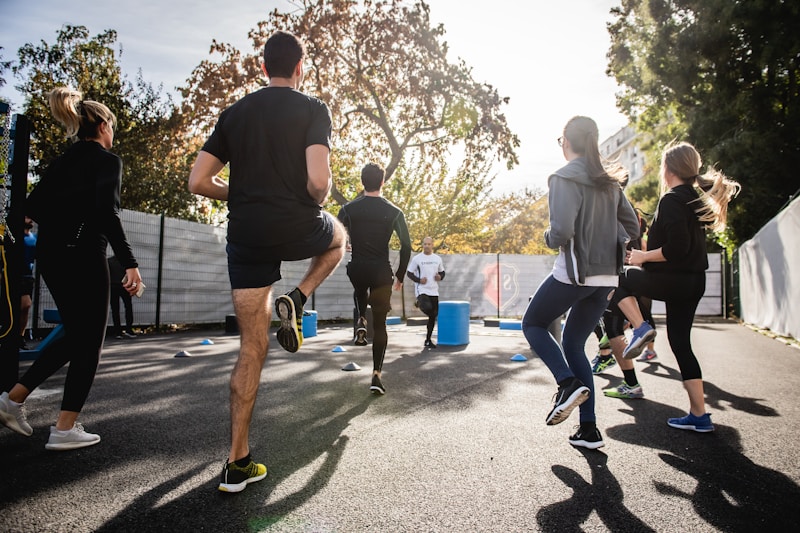9 Questions
What is the main difference between HIIT and traditional cardiovascular exercise?
Intensity
What is the difference between HIIT and SIT?
The intensity of the high-intensity periods
What is the most commonly involved injury during HIIT?
Knees
What is VO2 max?
The maximum amount of oxygen a person can consume during exercise
What is the potential benefit of HIIT for individuals with type 2 diabetes?
Reduced insulin resistance
What is the potential benefit of HIIT for individuals with hypertension?
Reduced blood pressure
What is the potential benefit of HIIT for overweight individuals?
Improved cardiorespiratory fitness
What is the recommended duration of a HIIT workout?
Under 30 minutes
What is brain-derived neurotrophic factor (BDNF)?
A protein that promotes the growth and survival of neurons
Study Notes
Overview of High-Intensity Interval Training (HIIT) and Sprint Interval Training (SIT)
-
HIIT involves alternating short periods of intense or explosive anaerobic exercise with brief recovery periods until the point of exhaustion.
-
HIIT relies on "the anaerobic energy releasing system almost maximally".
-
HIIT's crucial features of maximal effort, duration, and short rest periods distinguish it from being considered a form of cardiovascular exercise.
-
A HIIT workout typically lasts under 30 minutes in total.
-
Sprint interval training (SIT) is an exercise conducted in a similar way to HIIT, but instead of using "near maximal" effort for the high-intensity periods, "supramaximal" or "all-out" efforts are used in shorter bursts.
-
HIIT exercise sessions generally consist of a warm-up period followed by repetitions of high-intensity exercises separated by medium intensity exercises for recovery, then a cool-down period.
-
The specific exercises performed during the high-intensity portions vary, but may include cycling, rowing, running, stair climbing, and uphill walking.
-
HIIT training and traditional endurance training both lead to significantly improved cardiovascular fitness in healthy adults ages 18–45 but HIIT leads to greater improvements in VO2 max.
-
HIIT significantly lowers insulin resistance compared to continuous training or control conditions and leads to modestly decreased fasting blood glucose levels and increased weight loss compared to those who do not undergo a physical activity intervention.
-
HIIT can result in modest reductions of subcutaneous fat in young and healthy individuals, but greater reductions for overweight individuals.
-
There is a risk of injury due to fatigue and overtraining, so it is advised to allow time for recovery. Research from Rutgers University demonstrated that the knees, shoulders, and ankles were the most commonly involved injuries.
-
HIIT can elicit short term brain improvements similar to those usually observed with aerobic exercise.The Benefits of High-Intensity Interval Training (HIIT)
-
HIIT is a form of exercise that involves short bursts of intense exercise followed by brief periods of rest or recovery.
-
HIIT has been shown to be more effective than moderate-intensity continuous training (MICT) in improving cardiovascular health, increasing endurance, and reducing body fat.
-
A 2019 study found that HIIT improved vascular health by decreasing arterial wall thickness and increasing endothelial function, which allows for greater blood flow and oxygen supply throughout the body.
-
HIIT has also been found to be effective in lower back rehabilitation, with higher intensity exercise demonstrating greater effectiveness in reducing back pain and increasing muscle strength.
-
In overweight individuals, both HIIT and MICT have been found to be effective in improving cardiorespiratory fitness, with no evidence that either method is more effective than the other.
-
HIIT may also be used as prehabilitation for individuals awaiting surgery, as it can improve heart and lung fitness in a short period of time before surgery.
-
HIIT has been shown to increase brain-derived neurotrophic factor (BDNF), which is associated with improved cognitive function.
-
HIIT has been found to be effective in reducing insulin resistance and improving glucose metabolism, making it a potential treatment for type 2 diabetes.
-
HIIT has been found to be effective in reducing blood pressure, making it a potential treatment for hypertension.
-
HIIT has been found to be effective in improving mood and reducing symptoms of depression and anxiety.
-
HIIT has been found to be effective in improving athletic performance in elite athletes.
-
HIIT can be customized to fit individual fitness levels and can be done with or without equipment.
-
HIIT is a promising alternative to enhance cognition, improve vascular health, and improve overall fitness with short and potent exercise regimens.
Test your knowledge on High-Intensity Interval Training (HIIT) and Sprint Interval Training (SIT) with this quiz! See how much you know about the benefits of HIIT, the specific exercises involved, and the potential risks. Find out if you're ready to incorporate this popular form of exercise into your fitness routine. This quiz is perfect for anyone interested in learning more about HIIT and SIT, from fitness enthusiasts to beginners.
Make Your Own Quizzes and Flashcards
Convert your notes into interactive study material.





